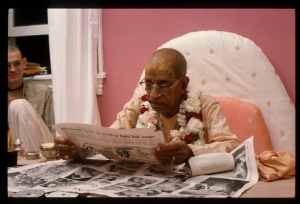CC Madhya 6.99 (1975)

A.C. Bhaktivedanta Swami Prabhupada
Below is the 1996 edition text, ready to be substituted with the 1975 one using the compile form.
TEXT 99
- kali-yuge līlāvatāra nā kare bhagavān
- ataeva ‘tri-yuga’ kari’ kahi tāra nāma
SYNONYMS
kali-yuge—in this Age of Kali; līlā-avatāra—a pastime incarnation; nā—not; kare—does; bhagavān—the Supreme Personality of Godhead; ataeva—therefore; tri-yuga—Triyuga (manifested in three yugas); kari’—accepting; kahi—I say; tāra nāma—His holy name.
TRANSLATION
“In this Age of Kali there is no līlā-avatāra of the Supreme Personality of Godhead; therefore He is known as Triyuga. That is one of His holy names.”
PURPORT
A līlā-avatāra is an incarnation of the Lord who performs a variety of activities without making any special endeavor. He always has one pastime after another, all full of transcendental pleasure, and these pastimes are fully controlled by the Supreme Person. The Supreme Person is totally independent of all others in these pastimes. While teaching Sanātana Gosvāmī (CC Madhya 20.296-298 (1975)), Śrī Caitanya Mahāprabhu pointed out that one cannot count the number of līlā-avatāras:
- līlāvatāra kṛṣṇera nā yāya gaṇana
- pradhāna kariyā kahi dig-daraśana
“However,” the Lord told Sanātana, “I shall explain the chief līlā-avatāras.” matsya, kūrma, raghunātha, nṛsiṁha, vāmana varāhādi—lekhā yāṅra nā yāya gaṇana Thus the Lord’s incarnations were enumerated, including Matsya, the fish incarnation; Kūrma, the tortoise; Lord Rāmacandra; Nṛsiṁhadeva; Vāmanadeva; and Varāha, the boar incarnation. Thus there are innumerable līlā-avatāras, and all of these exhibit wonderful pastimes. Lord Varāha, the boar incarnation, lifted the entire planet earth from the depths of the Garbhodaka Ocean. The tortoise incarnation, Lord Kūrma, became a pivot for the emulsification of the whole sea, and Lord Nṛsiṁhadeva appeared as half-man, half-lion. These are some of the wonderful and uncommon features of līlā-avatāras.
In his book Laghu-bhāgavatāmṛta, Śrīla Rūpa Gosvāmī has enumerated the following twenty-five līlā-avatāras: Catuḥ-sana, Nārada, Varāha, Matsya, Yajña, Nara-Nārāyaṇa, Kapila, Dattātreya, Hayaśīrṣa (Hayagrīva), Haṁsa, Pṛśnigarbha, Ṛṣabha, Pṛthu, Nṛsiṁha, Kūrma, Dhanvantari, Mohinī, Vāmana, Paraśurāma, Rāghavendra, Vyāsa, Balarāma, Kṛṣṇa, Buddha and Kalki.
Śrī Caitanya Mahāprabhu is not mentioned as a līlā-avatāra because He is an incarnation in disguise (channa-avatāra). In this Age of Kali there are no līlā-avatāras, but there is an incarnation of the Lord manifested in the body of Śrī Caitanya Mahāprabhu. This has been explained in Śrīmad-Bhāgavatam.